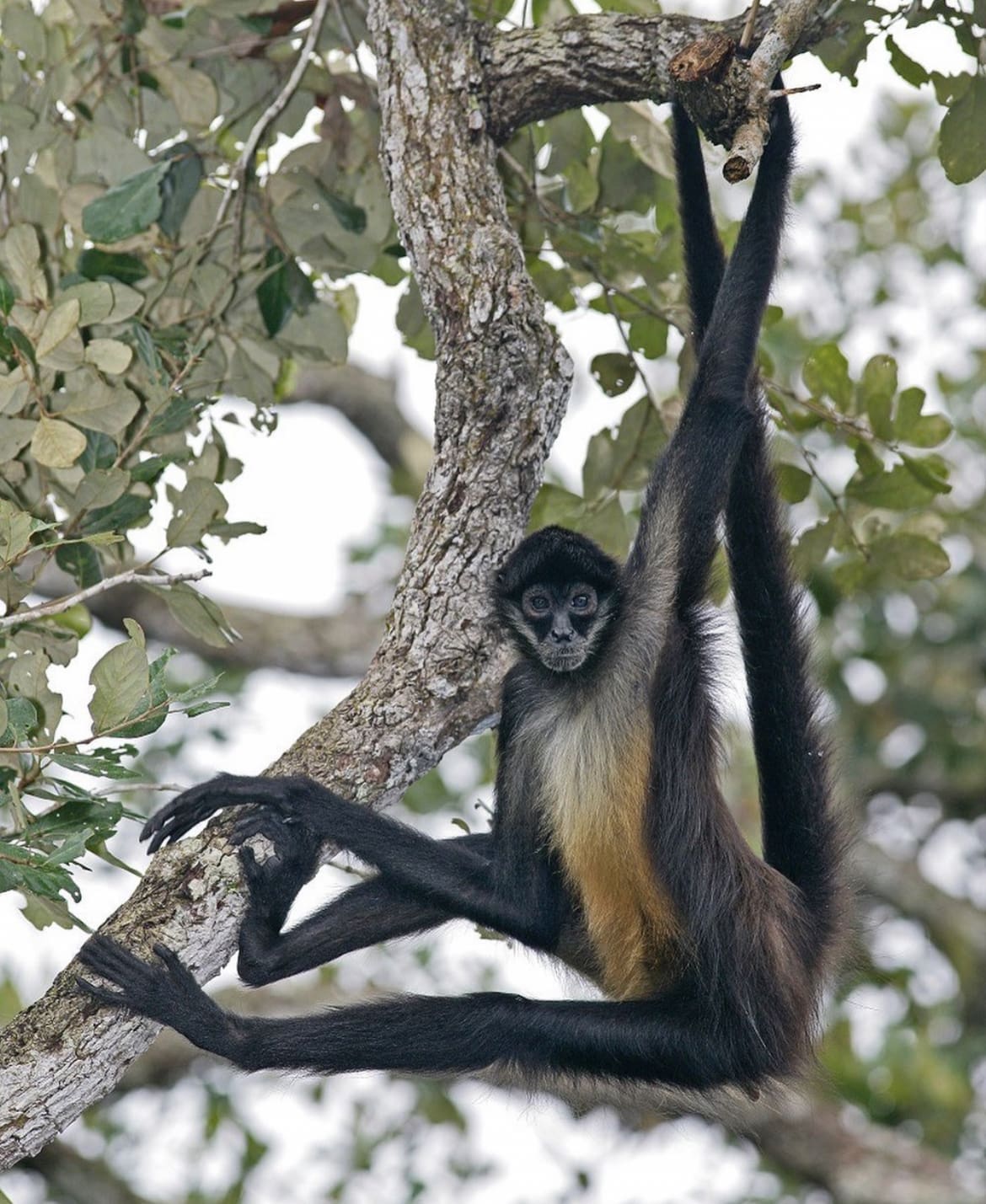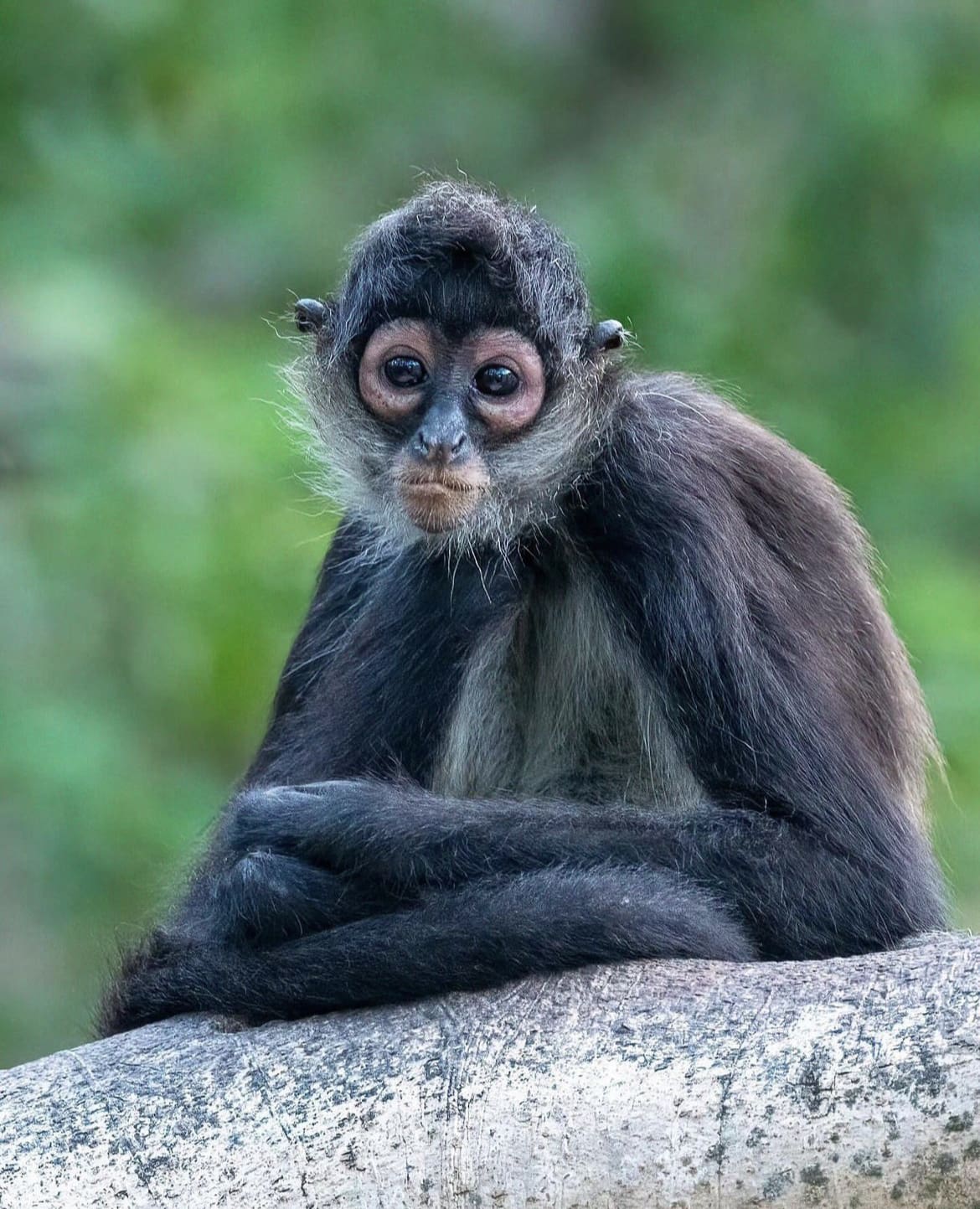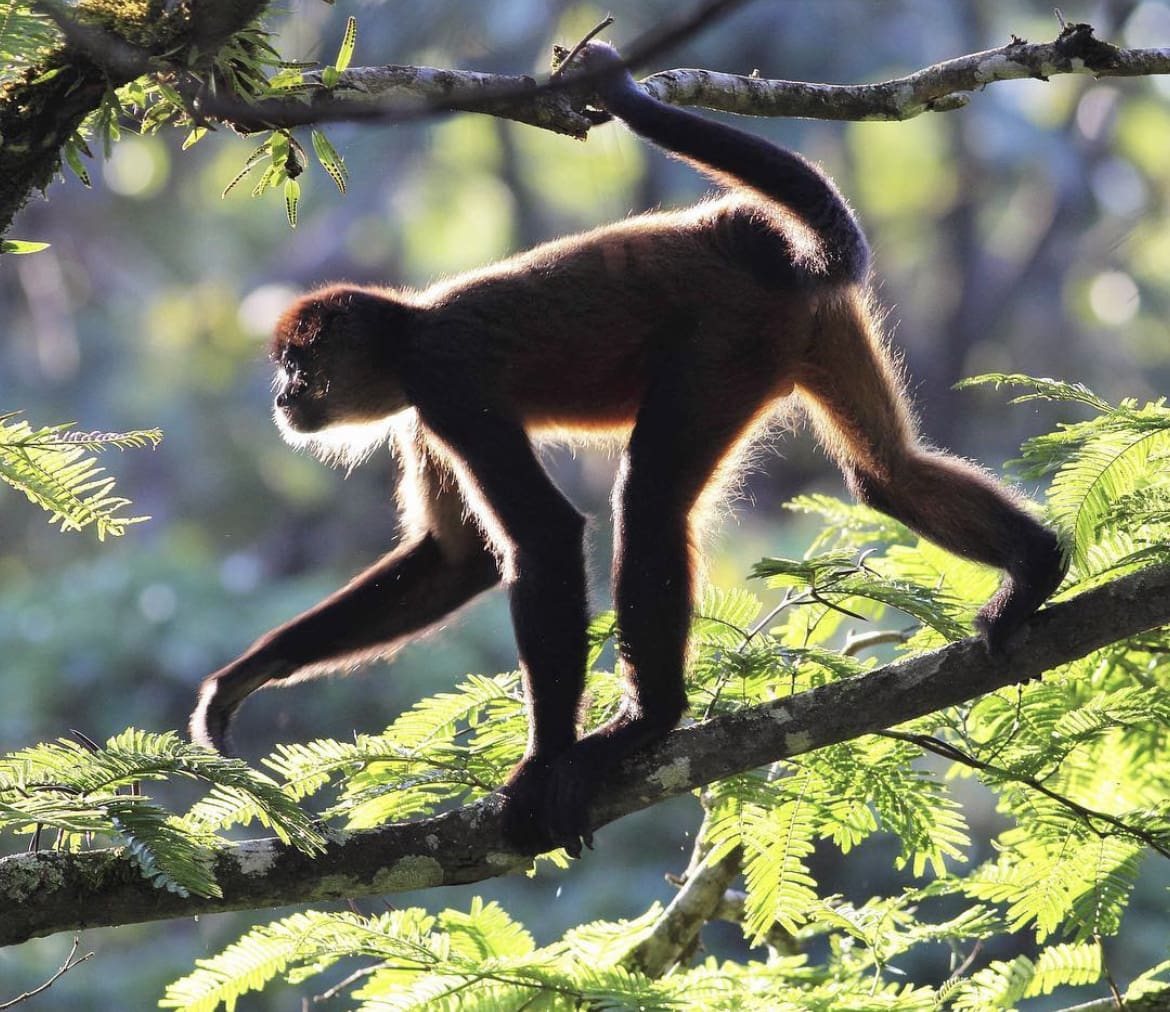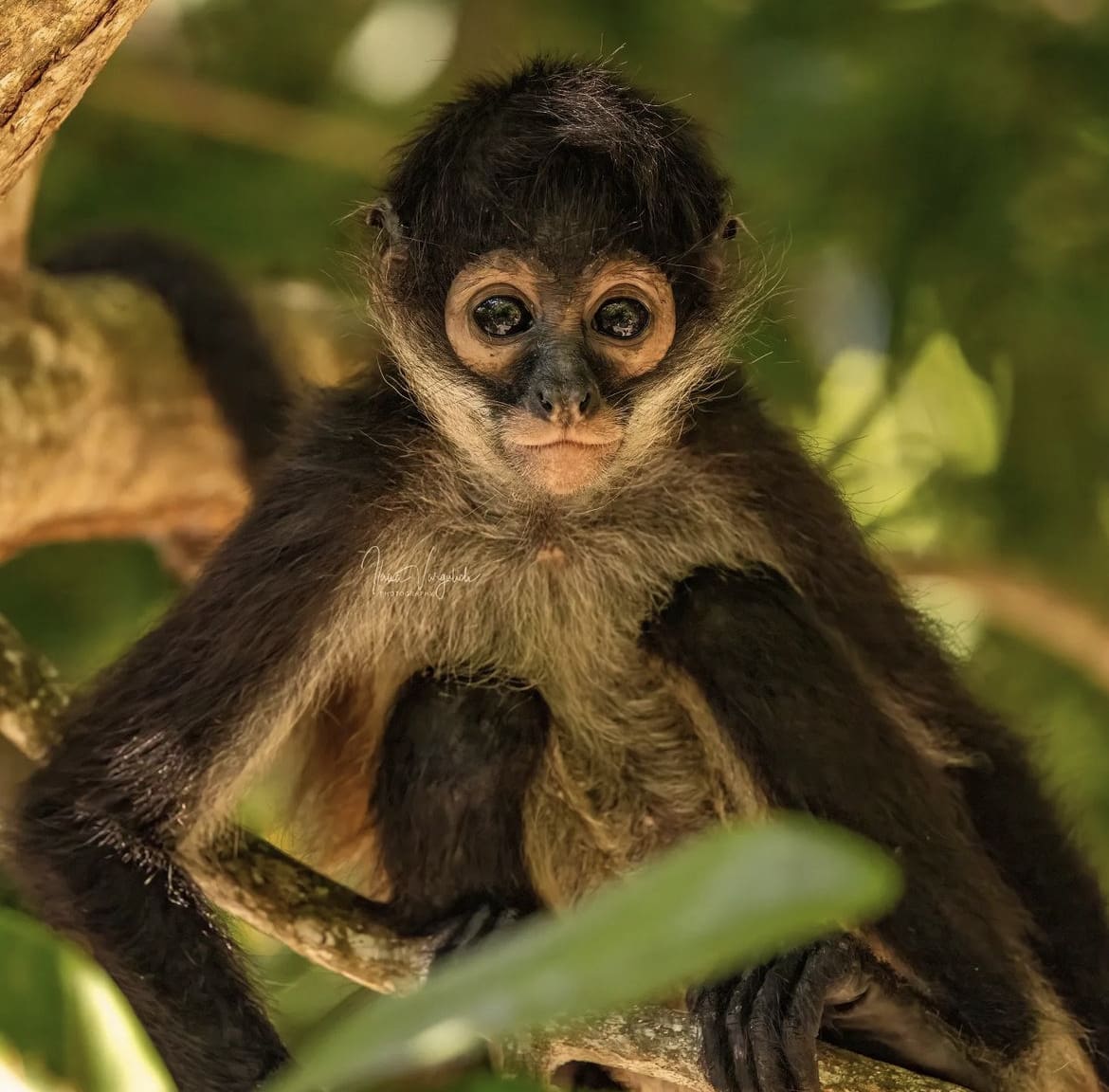There’s more to spider monkeys than just incredible meme content.
These agile acrobats of the rainforest, possess a vibe that’s as chill as your favorite laid-back playlist, but with just enough edge to keep things interesting.
This isn’t your average nature documentary script; think of it as a backstage pass to the life and times of the some of the forest’s coolest residents.
What is the Spider Monkey?
Imagine swinging through the treetops with the greatest of ease, your tail gripping branches like it’s got a mind of its own. Welcome to the day in the life of a spider monkey, the rainforest’s answer to a high-wire circus act. These guys are part of the primate family, which means they’re distant cousins to us. They hang out in groups, munch on fruits, and have the kind of social life that would put your favorite soap opera to shame.
There are several species of spider monkeys, each rocking their own style in different parts of Central and South America. The thing they all have in common? They’re incredibly adapted to life up high in the trees. With long limbs and tails that seem to function as an extra arm, they’re the embodiment of living the high life—literally.

Spider Monkey vs Howler Monkey
Now, if you’re thinking, “Monkey is a monkey, right?” think again. Spider monkeys and howler monkeys are like the yin and yang of the primate world. Howlers are the loud neighbors you hear before you see. They’re famous for their ear-splitting calls that can travel three miles through dense forest. Spider monkeys, on the other hand, are more the strong, silent type, relying more on body language and quieter communications.
Visually, spider monkeys win the lanky award with their long limbs and tails, while howler monkeys boast a stockier build and a less prehensile tail. Diet-wise, spider monkeys are the fruitarians of the treetops, preferring a juicy mango over anything else, while howler monkeys wouldn’t say no to a leafy green salad. And when it comes to hanging out, spider monkeys are all about that social life, moving in large, loose groups, whereas howler monkeys prefer their cliques a bit tighter.
What Do Spider Monkeys Look Like?
Ever seen a creature that looks like it was designed by a committee of kids? That’s your spider monkey right there. These critters have a decidedly unique look, with long, gangly limbs that make them look a bit like spiders dangling from webs—hence the name. Their fur can range from a sleek black to a brownish-red, depending on the species, making them the fashionistas of the forest.
But it’s not just about looks; these features are all about survival. Their long limbs allow them to reach for distant branches, and their tails—oh, those tails—are nothing short of marvelous. Prehensile, muscular, and capable of supporting their entire body weight, spider monkeys’ tails are the Swiss Army knives of the animal kingdom.
How Big Are Spider Monkeys?
In the world of spider monkeys, size definitely matters—but maybe not in the way you’d expect. These guys aren’t about bulking up; they’re more about the reach. On average, they can stretch about 16 to 24 inches from head to rump, with their tails adding another whopping 24 to 32 inches. That’s like having a built-in bungee cord attached to your backside. And when it comes to weight, they’re pretty lightweight, tipping the scales at around 15 to 19 pounds. That’s crucial for animals that spend most of their lives in trees; the lighter you are, the less likely you are to take an unexpected plunge.

Skin
Now, let’s talk about something we don’t often think about when it comes to monkeys: their skin. Spider monkeys sport a coat of fur, but beneath that, their skin is a game-changer. It’s tough enough to handle the scrapes and scratches that come with life in the forest, yet sensitive enough to help them navigate their complex environment.
Their skin has to be adaptable, capable of withstanding the varied temperatures and humidities of their rainforest homes. And color? It’s not just for show. The skin, especially around their faces, can range from shades of pink to black, adding an extra layer of expression to their already communicative faces.
Spider Monkey Teeth
You might not think of a fruit lover sporting a fearsome set of chompers, but spider monkeys have a dental setup that’s all about efficiency. They’ve got 32 teeth designed to deal with a diet that’s more varied than you might expect.
Sure, fruit is their go-to, but they’ll also munch on leaves, nuts, and the occasional insect or bird egg. Their teeth are flat and broad, perfect for grinding down plant material, but they’ve also got some sharp canines in there for dealing with tougher food items. It’s a dental Swiss Army knife, if you will, allowing them to chop, slice, and dice whatever the forest buffet serves up.
READ NEXT: GET TO KNOW THE MOUNTAIN GORILLA
Hands
In the realm of tree-dwellers, hands are everything. Spider monkeys have taken this to the next level with their uniquely adapted hands that look a bit like they forgot their thumbs at home. But don’t let this thumb-less appearance fool you; it’s a feature, not a bug. Their hands are elongated and hook-like, perfect for grasping branches and swinging with the grace of a trapeze artist.
This design allows for a grip that is both delicate and strong, capable of holding their entire body weight as they dangle or move with precision through their leafy world. The lack of thumbs reduces the chance of snagging on branches during high-speed travel, proving that in the evolutionary lottery, sometimes less is more.

Spider Monkey Tails
If the hands were the opening act, the spider monkey’s tail is the headliner. This isn’t just any tail; it’s a prehensile powerhouse, capable of supporting the monkey’s full body weight. The underside of the tail is endowed with a patch of bare skin, complete with unique ridges and textures, akin to a human fingerprint.
This patch provides extra grip, making their tail as adept at grabbing and holding as any other limb. In the treetops, the tail acts as a fifth hand, assisting in feeding, climbing, and even in social interactions. It’s a multi-tool that adds a level of versatility to their movement and lifestyle that is unmatched in the primate world.
What Do Spider Monkeys Eat?
Cue the feast in the treetops. Spider monkeys are primarily frugivores, with a diet that reads like a tropical fruit basket: mangoes, bananas, nuts, berries, and even the occasional leaf or flower make the list. This preference for fruit means they play a crucial role in their ecosystem as seed dispersers. As they munch on fruit and move through the forest, they’re essentially planting the next generation of trees.
But it’s not just about what they eat; it’s also about how they find it. Their foraging strategy is sophisticated, relying on a detailed knowledge of their home territory and the seasonal availability of foods. They’ll travel great distances for a meal, using memory and communication to track down the ripest pickings. This diet not only sustains them but also nurtures the forest, highlighting the interconnectedness of life within the ecosystem.
Social Structure
When it comes to living the high life, spider monkeys take a communal approach. Picture a loosely organized tribe, where everyone has a role, but there’s plenty of room for personal space. Their social structure is matriarchal, meaning the females call the shots. Groups, or troops, can range from a cozy gathering of a few individuals to a lively crowd of up to forty members.
However, don’t expect to see them all hanging out together like a big, furry flash mob. They prefer to split into smaller subgroups during the day to forage, which helps reduce competition for food. This strategy of fission-fusion dynamics is kind of like having a big extended family that gathers for special occasions but lives in separate houses. Communication is key in maintaining these social bonds, especially when they’re spread out in the forest, searching for the day’s meals.

Do Spider Monkeys Make Sounds?
Yes, and their vocal repertoire is as varied as the latest top 40 hits. While they might not reach the decibel levels of their howler monkey cousins, spider monkeys communicate using a sophisticated blend of barks, whistles, and chirps. These sounds serve a multitude of purposes, from signaling the discovery of a food source to alerting the troop of potential danger.
It’s not all about words, though; they also rely on body language, facial expressions, and even the occasional hug to get their point across. This multifaceted communication system ensures that, even out of sight, they’re never out of mind, maintaining the cohesion of their social network through the dense foliage of their rainforest home.
How Do Spider Monkeys Reproduce?
The birds do it, the bees do it, and yes, spider monkeys have their own take on the dance of life. In the world of spider monkeys, romance is a year-round possibility, with no fixed breeding season. Females are in charge, choosing their partners based on a variety of factors, including strength and social standing. After a gestation period of about 7 to 8 months, a single baby is born. These infants are the center of their mother’s world, clinging to her belly with a grip that would make any rock climber envious. For the first few months, they’re entirely dependent, slowly learning the ropes of tree-top living from the safety of mom’s back.
Motherhood in the spider monkey world is a solo gig; males don’t take part in rearing the young. However, they do play a role in the social education of the juveniles, integrating them into the troop’s intricate social fabric. It’s a childhood that combines constant learning with the joy of swinging from branch to branch, preparing them for the day they’ll take their place in the forest’s canopy as adults.

How Long Do Spider Monkeys Live?
In the wild, the life of a spider monkey is anything but a breeze, yet these resilient creatures can live up to 25 years, and sometimes even beyond, in the right conditions. Life in captivity offers a different story, with some individuals reaching the venerable age of 40.
This longevity is a testament to their adaptability and the complexity of their social structures, which provide support and security. The journey from a vulnerable infant clinging to its mother to a mature adult navigating the forest canopy is fraught with challenges, but it’s also a testament to the resilience and endurance of these remarkable animals.
Are Spider Monkeys Aggressive?
The word ‘aggressive’ doesn’t really fit the spider monkey profile. These creatures are more about chill vibes and social bonds than about picking fights. However, like any wild animal, they have their boundaries. Within their own groups, spider monkeys maintain peace through grooming and other bonding activities, but they can become defensive if they feel threatened or if their territory is invaded. It’s all about context.
In their interactions with humans, they’re generally wary and prefer to keep a safe distance, which is wise considering the threats humans pose to their habitat and survival. But don’t mistake their caution for cowardice; when push comes to shove, a spider monkey will stand its ground.
Are Spider Monkeys Territorial?
Absolutely, but their concept of territory is more about forest resources than about drawing lines in the canopy. Spider monkeys require large areas of rainforest to provide for their nomadic lifestyle and varied diet. Their territories can overlap with those of other groups, but conflicts are rare.
Instead of aggressive confrontations, spider monkeys opt for vocal displays or simply avoiding each other, underscoring their preference for peace over turf wars. This territorial behavior plays a crucial role in their survival, ensuring access to sufficient food sources and the space needed for their fission-fusion social dynamics.
It’s a delicate balance between community and competition, one that spider monkeys navigate with remarkable finesse.

How Fast Are Spider Monkeys?
When it comes to getting around in the treetops, spider monkeys are the Olympians of the rainforest. Their speed and agility are breathtaking, with movements so fluid and fast, they make it look like a walk in the park. They can reach speeds that are impressive for an animal of their size when swinging or “brachiating” through the trees.
This speed isn’t just about showing off; it’s a crucial survival skill, allowing them to escape predators and traverse large areas in search of food. Their ability to move swiftly and with such precision is a testament to their specialized adaptation to a life lived high above the forest floor.
Where Do Spider Monkeys Live?
Imagine the most vibrant, bustling, and life-filled place on Earth. Now, imagine it’s all happening above ground, in the canopy of the rainforest. That’s where you’ll find spider monkeys, making their homes in the dense forests of Central and South America. These areas provide not just the trees they need for their acrobatic lifestyle but also the variety of fruits that make up their diet.
However, their habitat is not uniform; it ranges from the lowland rainforests to mountainous regions, each with its own set of challenges and benefits. Sadly, these habitats are under threat, with deforestation and human encroachment shrinking the spaces where spider monkeys can live and thrive.
How Many Spider Monkeys Are There in the Wild?
Here’s where the story takes a sobering turn. The numbers are hard to pin down precisely, but what we know isn’t promising. Spider monkeys are facing a decline across their range, with some species listed as endangered or critically endangered. The primary culprit? Human activity, from deforestation for agriculture and urban development to illegal pet trade and hunting.
The exact numbers in the wild are challenging to estimate due to their vast and often inaccessible habitats, but conservationists agree: spider monkeys are in danger. This decline is not just a loss for the species but a warning sign of the health of our planet’s rainforests, the lungs of the Earth.

Are Spider Monkeys Endangered?
The status of spider monkeys on the endangered species list is a stark reminder of the fragility of our natural world. Several species of spider monkeys are classified as endangered or critically endangered by the International Union for Conservation of Nature (IUCN). This precarious position stems from a cocktail of threats, primarily habitat loss due to deforestation, but also including the illegal pet trade and hunting.
Each lost habitat or captured individual not only diminishes the species’ numbers but also erodes the genetic diversity crucial for their long-term survival. The endangered status of spider monkeys serves as a clarion call for conservation efforts to protect these mesmerizing creatures and their habitats.
Threats to Spider Monkeys in the Wild
The biggest threat to spider monkeys is the loss of their home. As forests fall to make way for agriculture, logging, and development, spider monkeys lose the intricate web of life that supports them.
Beyond habitat destruction, they also face threats from poaching, whether for food or the illegal pet trade. These activities not only harm individual animals but can also disrupt the delicate social structures essential for their survival.
The loss of vast stretches of rainforest also affects their role as seed dispersers, further impacting the ecosystem’s health and its ability to sustain life.
Where to See Spider Monkeys in the Wild
For those yearning to witness the grace and beauty of spider monkeys in their natural habitat, there are still places where this is possible. Protected areas and national parks in countries like Costa Rica, Brazil, and Mexico offer opportunities to see these primates swinging freely through the canopies.
Observing spider monkeys in the wild not only provides an unforgettable experience but also supports conservation efforts through eco-tourism, which can help fund protection and research initiatives.

Tips for Spotting Spider Monkeys
Spotting these elusive creatures requires patience and a bit of know-how. Early morning or late afternoon, when they are most active in search of food, is the best time for sightings.
Quietly walking along forest trails and keeping an eye on the canopy above increases your chances. Listening for the rustle of leaves or their distinctive calls can lead you to a troop.
Always maintain a respectful distance to avoid disturbing them and use binoculars for a closer look.
Facts about The Spider Monkey
- Spider monkeys have no thumbs, an adaptation that helps them swing through trees more efficiently.
- They are one of the largest New World monkey species.
- Their prehensile tails can support their entire body weight.
- Spider monkeys play a crucial role in their ecosystem as seed dispersers.
Myths about The Spider Monkey
- Myth: Spider monkeys make good pets. Reality: They are wild animals with complex social needs and can become aggressive when kept in captivity.
- Myth: Spider monkeys are common and not at risk. Reality: Many species are endangered and face serious threats from human activities.
Our journey through the world of spider monkeys unveils a story of beauty, complexity, and challenge. These creatures are not just fascinating subjects of study or exotic figures moving through the trees.
They are integral threads in the tapestry of our planet’s biodiversity, playing roles that sustain the forests they, and ultimately we, depend on. Their plight is a poignant reminder of the impacts of human activity on the natural world and a call to action for their preservation.
By understanding their lives, appreciating their beauty, and recognizing their vulnerability, we can begin to change the narrative, from one of loss and decline to one of conservation and hope.
